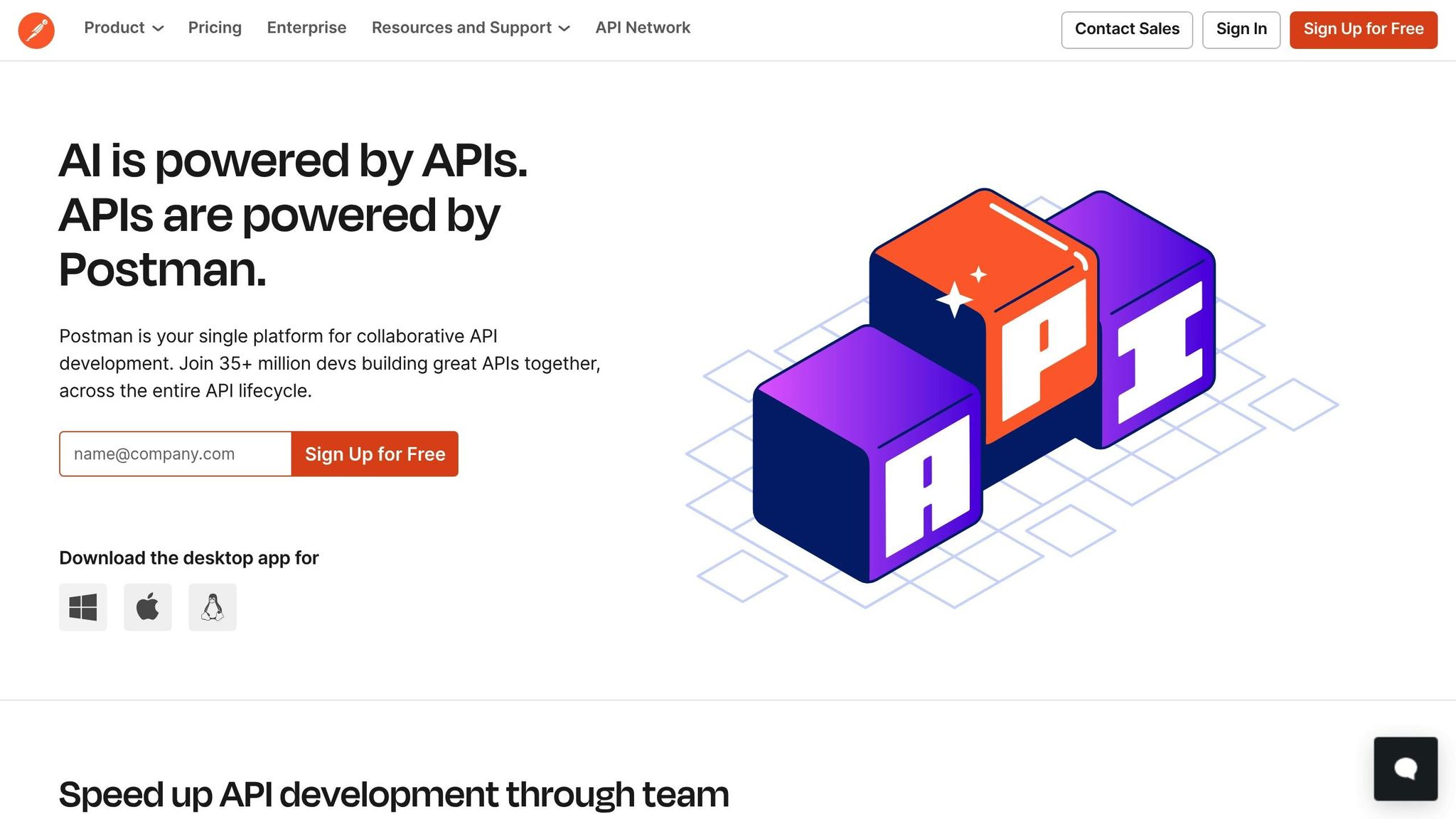Validating API integrations ensures accurate data sharing, system reliability, and resource efficiency. Here's how you can ensure your marketing tools work seamlessly together:
- Set Clear Goals: Focus on performance (response times under 200ms, handling 1,000+ calls/min), data accuracy, and business logic.
- Review API Documentation: Understand authentication, endpoints, rate limits, and error handling.
- Create Test Cases: Test core functions, edge cases, and error handling scenarios.
- Test Performance: Measure response times, simulate traffic surges, and monitor load handling.
- Verify Security: Test authentication, encryption, and compliance with data standards like GDPR.
- Use Tools: Leverage Postman, Swagger, and JMeter for testing and automation.
Quick Tip: Automate tests and use mock servers to simulate scenarios for ongoing validation.
Table of Tools and Their Uses:
| Tool | Purpose | Key Feature |
|---|---|---|
| Postman | API Testing | Collection Runner |
| Swagger | API Design | Interactive Testing |
| JMeter | Load Testing | Performance Analysis |
| SoapUI | Functional Testing | Automated Test Suites |
A solid validation process ensures smooth marketing operations and minimizes errors. Ready to optimize your API integrations? Start with these steps!
Master API Testing: Proven Postman Strategies That Work

Getting Ready for Validation
Setting up for effective API validation requires solid planning and attention to detail.
Define Testing Goals
Start by outlining the objectives for your integration. Focus on these key areas:
Performance Metrics
- Aim for response times under 200 ms.
- Ensure the system can handle over 1,000 calls per minute.
- Keep error rates below 0.1%.
Data Validation Requirements
- Confirm the accuracy of each field.
- Maintain consistent data formats.
- Account for special characters and edge cases.
Business Logic Verification
- Ensure campaign tracking is accurate.
- Validate conversion attribution rules.
- Check customer segmentation criteria.
Once goals are clear, use the API documentation to confirm they align with the system's capabilities.
Check API Documentation
Carefully review the API documentation to understand its requirements and limitations.
Key Documentation Elements
- Authentication methods and security protocols.
- Rate limit details.
- Required headers and parameters.
- Response codes and error handling processes.
- Data formats like JSON or XML structures.
| Documentation Component | Review Points | Priority |
|---|---|---|
| Authentication | Authentication methods | High |
| Endpoints | Base URLs, path parameters, query strings | High |
| Data Schemas | Required fields, data types, constraints | Medium |
| Error Codes | Standard responses, custom error handling | Medium |
| Rate Limits | Daily/hourly caps, burst limits | Low |
After confirming the documentation, move on to creating test cases that cover both routine and edge scenarios.
Create Test Cases
Develop test cases to evaluate the API thoroughly. Cover these areas:
Core Functionality Tests
- Check CRUD operations, data transformations, and workflow integration.
Edge Case Scenarios
- Handle incomplete or missing data.
- Test for timeout issues.
- Process duplicate records.
- Address rate limit exceptions.
Error Handling Tests
- Test invalid authentication attempts.
- Handle malformed requests.
- Simulate network interruptions and recoveries.
- Test responses to rate limit violations.
For each test case, document the following:
- Expected inputs and outputs.
- Success criteria.
- Required test data.
- Dependencies on other systems.
Thoroughly planned test cases will help ensure the API performs well and integrates seamlessly.
API Validation Process
Test Basic Functions
Start by verifying the core functionality of each API endpoint:
Data Accuracy Testing
- Check that campaign attribution data aligns across all systems.
- Confirm customer segments sync without errors.
- Ensure conversion tracking delivers precise results.
- Verify UTM parameters are passed as expected.
Response Validation
Focus on these areas:
- Validate data at the field level.
- Handle special characters appropriately.
- Ensure correct data type conversions.
- Confirm timestamps are accurate across time zones.
| Test Type | Success Criteria | Common Issues |
|---|---|---|
| Data Format | Consistent JSON/XML structure | Malformed responses |
| Field Mapping | Matches 100% with source data | Missing or null values |
| Character Encoding | UTF-8 compliance | Corruption of special chars |
| Date/Time | ISO 8601 format adherence | Timezone mismatches |
After confirming functionality, evaluate how the API performs under stress.
Test Speed and Load
Performance metrics are essential to understanding how the API handles real-world demands.
Response Time Monitoring
Measure API response times under various conditions:
- Peak load: Assess how the API performs during high-traffic periods.
- Concurrent requests: Test the system's ability to handle multiple calls simultaneously.
Load Testing Parameters
Simulate realistic scenarios to stress-test the API:
- Traffic surges during campaign launches.
- Multi-channel tracking events occurring simultaneously.
Once performance is verified, the next step is to secure the API.
Verify Security Measures
Authentication Testing
- Ensure API key rotation works as expected.
- Test how tokens handle expiration.
- Confirm rate limiting is enforced to prevent abuse.
- Validate IP whitelisting for controlled access.
Data Protection Verification
- Check that PII (Personally Identifiable Information) is encrypted.
- Verify secure transmission of sensitive data like campaign budgets.
- Test role-based access controls to restrict unauthorized actions.
- Monitor audit logs for unusual activity.
Compliance Checks
Ensure compliance with data governance standards:
- Confirm data retention policies are followed.
- Test integration of consent management systems.
- Verify GDPR compliance where applicable.
- Check that audit trails are complete and reliable.
sbb-itb-5174ba0
Testing Tools and Methods
Specialized tools play a key role in making API testing more efficient and secure.
Popular Testing Tools
There are several tools designed to validate marketing API integrations. Postman is widely known for testing API endpoints and creating documentation. It offers features like test collections, response validation, and automation.
Swagger (OpenAPI) stands out for its:
- Interactive documentation
- Request and response validation
- Schema verification
- Built-in security testing capabilities
Apache JMeter is perfect for simulating heavy user loads:
- Tests how APIs perform under high traffic
- Measures response times
- Allows custom test scenarios
| Tool | Purpose | Key Feature |
|---|---|---|
| Postman | API Testing | Collection Runner |
| Swagger | API Design | Interactive Testing |
| JMeter | Load Testing | Performance Analysis |
| SoapUI | Functional Testing | Automated Test Suites |
These tools provide a solid foundation for controlled and thorough testing.
Mock Server Testing
Mock servers allow you to test scenarios like:
- Campaign tracking setups
- Adjustments to attribution models
- Custom conversion events
- Error handling cases
By setting up mock responses, you can check how your marketing tools respond to different situations:
- Success responses with various data formats
- Error conditions and edge cases
- Rate limit scenarios
- Timeouts
Once you've tested these responses, you can automate the process to ensure ongoing validation.
Automated Testing
Automating your tests ensures consistent checks for:
- Data transformation accuracy
- Proper handling of campaign parameters
- Attribution logic
- Cross-channel tracking behavior
Integrate these tests into your Continuous Integration Pipeline to include:
- Automated smoke tests for key endpoints
- Regular checks on authentication flows
- Performance benchmarks
- Data integrity verifications
Set up monitoring alerts to catch issues like:
- Slower response times
- Unexpected changes in data formats
- Authentication errors
- Breakpoints in integrations
API Testing Guidelines
To ensure consistent API validation, follow these structured guidelines based on verified test cases and processes.
Use Sample Data
Work with test data that closely resembles real-world scenarios:
- Campaign data with various UTM parameters
- Multi-channel attribution models
- Different types of conversion events
- A range of customer journey interactions
| Data Type | Sample Size | Validation Focus |
|---|---|---|
| Campaign Data | 100-500 records | UTM tracking, source attribution |
| Conversion Events | 1,000+ events | Goal tracking, revenue accuracy |
| User Interactions | 5,000+ sessions | Event sequencing, timestamp accuracy |
| Custom Parameters | 200-300 variations | Parameter handling, encoding issues |
Once your sample data is ready, carefully track and document your test results for further analysis.
Track Test Results
Keep a close eye on API performance and document findings to identify potential problems.
Metrics to Watch:
- Average response times for each endpoint
- Success rates for data transformations
- Frequency of errors by endpoint
- Scores for data accuracy validation
Use a centralized dashboard to display:
- Real-time test status updates
- Historical performance trends
- Detailed error logs
- Data validation outcomes
Pro tip: Automate alerts for key thresholds, like accuracy dropping below 98% or response times exceeding 500ms.
Team Communication
Tracking test results effectively helps teams address integration challenges. Use clear communication strategies to streamline this process:
-
Regular Sync Meetings
Hold bi-weekly sessions to:- Review recent test outcomes
- Discuss accuracy and data concerns
- Plan for upcoming integration updates
- Address discrepancies in tracking
-
Shared Documentation and Issue Resolution
Maintain a shared system to document and resolve issues. Include:- API endpoint details
- Data transformation rules
- Validation test cases
- Known constraints
- Issue severity levels
- Expected response times
- Troubleshooting guidelines
- Resolution tracking
Recommended Tools:
| Purpose | Tool | Update Frequency |
|---|---|---|
| Test Results | Dashboard | Real-time |
| Issue Tracking | Ticket System | Daily |
| Documentation | Wiki | Weekly |
| Team Updates | Email Digest | Bi-weekly |
Conclusion
Key Points to Remember
API validation plays a critical role in making marketing tool integrations reliable. Here’s what matters most: thorough validation ensures data accuracy, regular monitoring keeps systems running smoothly, and strong validation processes improve overall system performance.
Use these tips to strengthen your integration process. Ready to improve your marketing tool integrations? Check out the Marketing Analytics Tools Directory for solutions that simplify testing and help you implement best practices.


